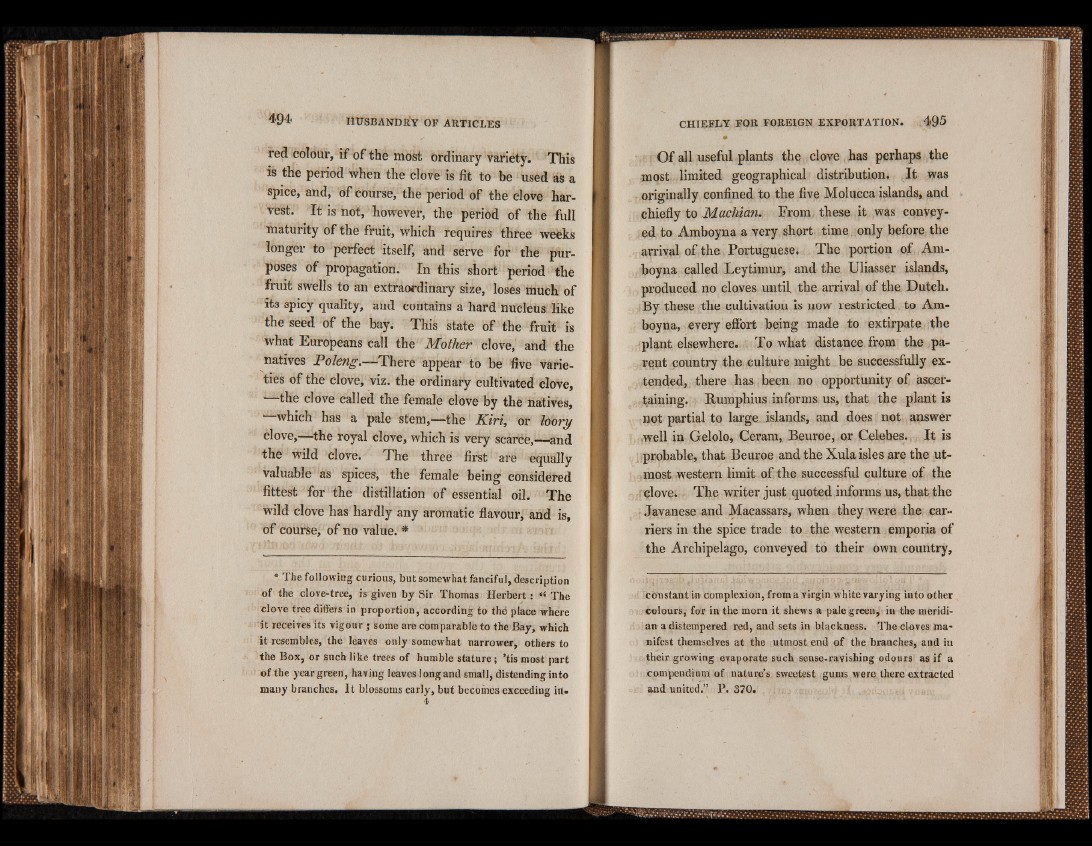
red colour, if of the most ordinary variety. This
is the period when the clove is fit to be used as a
spice, and, of course, the period of the clove harvest.
It is not, however, the period of the full
maturity of the fruit, which requires three weeks
longer to perfect itself, and serve for the purposes
of propagation. In this short period the
fruit swells to an extraordinary size, loses much of
its spicy quality, and contains a hard nucleus like
the seed of the bay. This state of the fruit is
what Europeans call the Mother clove, and the
natives PoJeng.—There appear to be five varieties
of the clove, viz. the ordinary cultivated clove,
the clove called the female clove by the natives,
which has a pale stem,'—the Kiri, or loory
clove,—the royal clove, which is very scarce,—and
the wild clove. The three first are equally
valuable as spices, the female being considered
fittest for the distillation of essential oil. The
wild clove has hardly any aromatic flavour, and is,
of course, of no value. *
* The following curious, but somewhat fanciful, description
of the clove-tree, is given by Sir Thomas Herb ert: “ The
clove tree differs in proportion, according to thé place where
it receives its vigour; some are comparable to the Bay, which
it resembles, the leaves only somewhat narrower, others to
the Box, or such like trees of humble stature; ’tis most part
of the year green, having leaves long and small, distending into
many branches. I t blossoms early, but becomes exceeding in.
4
Of all useful plants the clove has perhaps the
most limited geographical distribution. It was
originally confined to the five Molucca islands, and
chiefly to Machian. From these it was conveyed
to Amboyna a very short time only before the
arrival of the Portuguese. The portion of Amboyna
called Leytimur, and the Uliasser islands,
produced no cloves until the arrival of the Dutch.
By these the cultivation is now restricted to Amboyna,
every effort being made to extirpate the
plant elsewhere. To what distance from the parent
country the- culture might be successfully extended,
there has been no opportunity of ascertaining.
Rumphius informs us, that the plant is
not partial to large islands, and does not answer
well in Gelolo, Ceram, Beuroe, or Celebes., It is
probable, that Beuroe and the Xula isles are the utmost
western limit of the successful culture of the
clove. The writer just quoted informs us, that the
Javanese and Macassars, when they were the carriers
in the spice trade to the western emporia of
the Archipelago, conveyed to their own country,
constant in complexion, from a virgin white varying into other
colours, for in the morn it shews a pale green, in the meridian
a distempered red, and sets in blackness. The cloves manifest
themselves at the utmost end of the branches, and in
their growing evaporate such sense.ravishing odours as if a
compendium of nature’s sweetest gums were there extracted
and united.” P. 370.